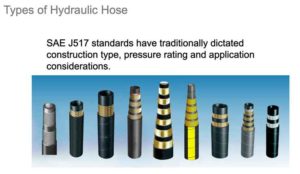
Josh Cosford
Josh Cosford returns to the Fluid Power Technology Conference (FPTC) once again to bring a technical deep dive with a bit of humor thrown in for attendees. At the Cleveland FPTC November 18-20, Cosford will present his latest talk, 100R2 Is not a Star Wars droid — find out what it and other SAE J517 standards mean, on Tuesday, November 19, from 10:30 to 11:15 a.m.
The SAE J517 hose standard defines common hydraulic hose construction types to help you avoid confusion while choosing the best hose type for your application. Cosford will break down the difference between 100R1 and 100R19 hose, and everything in between. Fluid type, pressure rating and even flexibility will come into play, so join me to discover the specifics of the sometimes confusing hose rating system you see so often.
This SAE standard provides general, dimensional and performance specifications for the most common hoses used in hydraulic systems on mobile and stationary equipment. He will begin with the 100R1, the a typical one wire design that people will describe on a standard hydraulic hose, all the way up to a 100R19 which is a more modern configuration of hose becoming quite popular.
 Cosford will discuss what each one is, how it’s constructed, what it’s advantages and disadvantages are and what kind of applications are used in more often than not.
Cosford will discuss what each one is, how it’s constructed, what it’s advantages and disadvantages are and what kind of applications are used in more often than not.
Cosford comes to FPW from Higginson Equipment in Burlington, Ontario where he is the general manager. He studied fluid power at Mohawk College in Hamilton, Ontario. He has more than a decade of experience with fluid power systems, and has held the certified fluid power hydraulic specialist designation from the Fluid Power Society since 2009.
Cosford has been involved in the design and sales of hydraulic systems since 2006. He is the director of communications for Canadian Fluid Power Society and he is the Fluid Power world favorite, contributing to both our magazine and many websites regularly.
Filed Under: Hose Assembly Tips